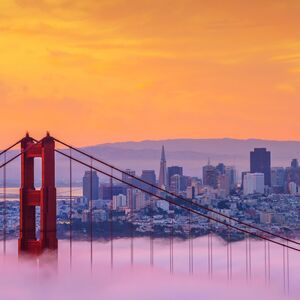
Margaret & David
Margaret & David
Exploring San Francisco
We have a long history with San Francisco and, at some point in each of our lives, have called it home. While we never knew one another in all the years we were residents of the City by the Bay, we later discovered there were so many of the same places we both visited often and, several times, convinced we crossed paths and never knew it.
While you are here, I truly hope you will have time enough to experience the richness if its history and appreciate its uniqueness and incredible beauty. Explore what the city has to offer! If you're not sure where to go, below are a few popular destination spots!
Known by the locals as, The City, San Francisco spans 47.355 square miles (122.6 square kilometers) and is the second most densely populated major city in America, (New York being the first, of course).
SEE THE GOLDEN GATE BRIDGE
Crossing the strait of the Golden Gate from San Francisco’s Presidio to the Marin headlands is the world-renowned Golden Gate Bridge, easily identified by its International Orange color. Once called “the bridge that couldn’t be built,” today the Golden Gate Bridge is one the seven wonders of the modern world. This magnificent span, perhaps San Francisco’s most famous landmark, opened in 1937 after a four-year struggle against relentless winds, fog, rock and treacherous tides.
The 1.7-mile-long bridge is anchored by towers that reach 746 feet skyward and was once taller than any building in San Francisco! To support the suspended roadway, two cables—each more than 7,000 feet in length and containing 80,000 miles of wire—stretch over the top of the towers and are rooted in concrete anchorages on shore.
The Golden Gate Bridge brought the communities of San Francisco and Marin counties closer together and became one of the most driven sections of historic U.S. Route 101, which stretches from Los Angeles north to San Francisco and beyond. It’s equally popular with hikers and cyclists, and is the main attraction for runners partaking in any of our many local annual foot races.
Golden Gate Bridge | Golden Gate View Points | The Presidio (San Francisco)
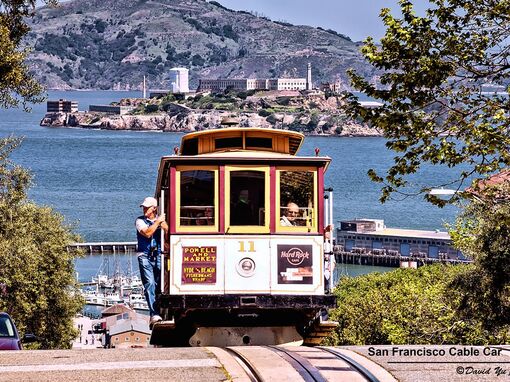
RIDE A CABLE CAR
Well before the bell-dings of Rice-A-Roni ads brought long lines of tourists, cable cars were a mainstay of San Francisco transportation. In fact, cable cars reigned. At twice the speed of horse-pulled carriages, these boxy rattlers could climb the city’s steepest hills when horses wouldn’t dare.
San Francisco’s remains today as one of the world’s last manually operated cable car systems. Our transit scene was transformed by these standard-gauge open-sided cars as commuters sat, stood, and hung from the sides while they trundled happily throughout the city at a steady 9 miles per hour — running as far west as 12th avenue, while also winding into the Presidio, through Castro’s hilly terrain and into Noe Valley, and even to Bernal Heights. With 23 lines (all established from 1873 to 1890) doing the former job of horses, the cars would shuttle folks up and over the hills and down Market Street to the Ferry Building. It wasn’t the end of the wars, San Francisco eventually took over Cal Cable in 1952, and city hall succeeded in removing half our streetcar tracks. Dozens of the double-ended maroon-and-yellow cable cars were sold off as surplus.
A New Era
The whole cable car system was falling into disrepair by the 1960s. The cables were worn and frayed. The electric motors powering them were on the fritz.
But in 1982, Mayor Dianne Feinstein personally led a campaign to completely rebuild the entire cable car system. To get it done, she partnered up with Mick Jagger, who posed for a photo op and made a brief appearance at San Francisco City Hall in support of saving the streetcars. Feinstein’s efforts paid off.
The cars were spruced up and repaired. The shabby tracks were shined. The spiffy reconstructed car barn was promised to last another century.
San Francisco cable cars are synonymous with San Francisco and it’s crazy cool charm and uniqueness. If you do anything while you are in the City, ride the cable car!
Cable cars in San Francisco: Everything to know (sfgate.com)

HAVE AN IRISH COFFEE AT BUENA VISTA CAFÉ
The historic venture started on the night of November the 10th in 1952. Jack Koeppler, then-owner of the Buena Vista, challenged international travel writer Stanton Delaplane to help re-create a highly touted "Irish Coffee" served at Shannon Airport in Ireland. Intrigued, Stan Accepted Jack’s invitation, and the pair began to experiment immediately.
Throughout the night the two of them stirred and sipped judiciously and eventually acknowledged two recurring problems. The taste was "not quite right," and the cream would not float. Stan’s hopes sank like the cream, but Jack was undaunted. The restaurateur pursued the elusive elixir with religious fervor, even making a pilgrimage overseas to Shannon Airport.
Upon Jack’s return, the experimentation continued. Finally, the perfect-tasting Irish whiskey was selected. Then the problem of the bottom-bent cream was taken to San Francisco’s mayor, a prominent dairy owner. It was discovered that when the cream was aged for 48 hours and frothed to a precise consistency, it would float as delicately as a swan on the surface of Jack’s and Stan’s special nectar.
Success was theirs! With the recipe now mastered, a sparkling clear, six-ounce, heat-treated goblet was chosen as a suitable chalice.
Soon the fame of the Buena Vista’s Irish Coffee spread throughout the land. Today, it’s still the same delicious mixture, and it’s still the same clamorous, cosmopolitan Buena Vista. Both…delightful experiences.
Buena Vista Café
2765 Hyde Street
San Francisco, CA 94109
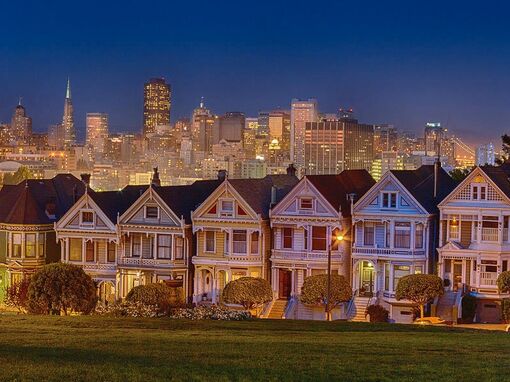
VIEW THE PAINTED LADIES
The Painted Ladies of San Francisco are a must-see on your visit. You'll find the most famous set across the street from Alamo Square Park along Steiner Street. You will also hear them called the Seven Sisters or Postcard Row.
But that’s not the only place you will find them.
Other top spots include streets around the Alamo Square District, the Haight-Ashbury, the Castro, Pacific Heights, and the Lower Haight.
San Francisco builders started putting up Victorian houses around San Francisco in the mid-1800s. They built thousands of them, but it came to an abrupt stop in April 1906.
This is when San Francisco was hit by one of its largest earthquakes in history. This massive quake destroyed hundreds of Victorian homes and a large part of SF.
However, the fires that raged for days after the earthquake took the largest toll on the city and these gorgeous houses.
To help preserve the western and southern neighborhoods, the city built a fire line along Van Ness Street.
This is why you will find hundreds of Victorians on the western side of the city, but not very many painted ladies in the eastern districts such as Nob Hill, North Beach, and Telegraph Hill.
After the destruction around the city, it took years to rebuild it. Even though the earthquake destroyed thousands of these homes, they decided to rebuild them up until around 1915.
The next interesting period for these beauties is during the First World War and Second World War.
As these homes aged, thousands were destroyed and replaced with more modern houses.
Many of those that owned these Victorian homes started to spruce them up by using left-over battleship grey paint from the Navy to repaint them.
YUCK!!! Can you imagine all these gorgeous houses with cheap gray paint? I don’t want to even think about it.
The houses stayed this way for several years as the paint was inexpensive, easy to get, and seemed okay since other homeowners were doing the same during this time.
Luckily, we can thank artist Butch Kardum as the creative genius behind the change back to brightly colored Victorians. In 1963, he painted his house bright colors including a combination of blues and greens.
Some people loved it, some hated it. Those that loved his colorful home decided to do the same with theirs.
This started a trend that was eventually dubbed the "Colorist Movement."
It led to the writing of the book mentioned above about the painted ladies which gave them a new name. It also allowed even more homeowners the freedom to express their creativity on the outside of their homes.
This trend continues today as more and more homeowners add bright colors of paint to highlight the lovely details of these historic homes.
Now that you know a bit about the painted ladies let's talk about where you can find some of the best houses around San Francisco.
I’ll start with the most well-known set, the famous Painted Ladies of Alamo Square.
These seven sisters line up along Steiner Street just to the east of Alamo Square Park.
Six are the same, and then one larger sister on the northern end. This is why they are called the Seven Sisters.
The beauty of this set is not just in the houses but the fact that they are easy to photograph without any homes across the street because it is the park. More than that, you can also climb the hill at Alamo Square Park to get a beautiful view of downtown SF behind them.
These are two of the reasons they are also called Postcard Row.
You will find them (from south to north) at 710, 712, 714, 716, 718, 720, and 722 Steiner Street.
Does anyone live in the Painted Ladies San Francisco?
Yes, all seven are privately owned, and you are not allowed to visit inside them. When visiting, please be respectful to the people living in these homes.
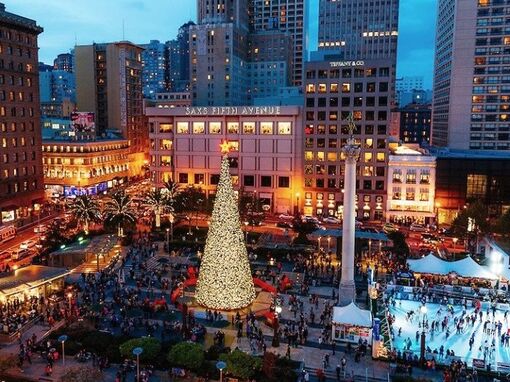
GO SHOPPING AT UNION SQUARE
The hotel we are to be married in, Kensington Park Hotel, is in Union Square, so why not experience the loveliness that is Union Square!
Union Square is a 2.6-acre public plaza located in downtown San Francisco, California. It is bordered by Geary, Powell, Post, and Stockton Streets. The name “Union Square” also refers to the surrounding central shopping, hotel, and theater district that spans several blocks1
. Here are some interesting details about Union Square:
1. Historical Significance:
During the American Civil War, Union Square was used for rallies and support for the Union Army, which is how it earned its name. It is designated as a California Historical Landmark2.
Over time, it has evolved into a major tourist destination and a cosmopolitan gathering place in downtown San Francisco.
2. Shopping and Entertainment:
Union Square boasts one of the largest collections of department stores, upscale boutiques, gift shops, art galleries, and beauty salons in the United States.
It’s a premier shopping district, attracting visitors from all over the world.
3. Perfect Day in Union Square:
Start your day with coffee and pastries at One65, a French patisserie in Union Square.
Explore six floors of dining options, including Michelin-starred restaurants and unique cafes.
Don’t miss riding the world-famous cable cars, which are an iconic part of San Francisco’s charm.
Whether you’re a local or a visitor, Union Square offers a vibrant blend of history, shopping, and entertainment!

ESCAPE TO ALCATRAZ ISLAND
Alcatraz was the site of the first lighthouse in the Western United States but became a federal penitentiary from 1934 to 1963, housing famous convicts such as Al Capone and George "Machine Gun" Kelly. Now, this once infamous prison island is part of the Bay Area’s 80,000-acre Golden Gate National Recreation Area.
Located one-and-a-half miles from Fisherman's Wharf, Alcatraz is one of the city's most popular attractions. A visit to the island includes a tour of the cell house where visitors can see how the prisoners lived. Although the last inmates were transferred off the island in 1963, the main prison block—with its steel bars, claustrophobic (9 x 5-foot) cells, mess hall, library and "dark holes," is still structurally intact.
Alcatraz is located in San Francisco Bay, approximately 1.25 miles (2.01 km) from the northern shore of San Francisco. To get there, take an Alcatraz Cruises from Pier 33 Alcatraz Landing, located along San Francisco’s northern waterfront promenade, on The Embarcadero near the intersection of The Embarcadero and Bay Streets, located approximately 1/4 mile from San Francisco’s Fisherman’s Wharf. Allow at least 2 ½ – 3 hours for sailing to the Island, exploring the island, and returning to Pier 33 Alcatraz Landing. The trip over to Alcatraz Island is 12-15 minutes each way and is factored into the suggested visit time.
Some movies Alcatraz was featured in:
- The rock (1996)
- Murder in the First (1995)
- Escape from Alcatraz (1979)
- Birdman of Alcatraz (1963)
Alcatraz Tours | Alcatraz Tickets | Alcatraz Island Ferry – AlcatrazIslandTickets.com
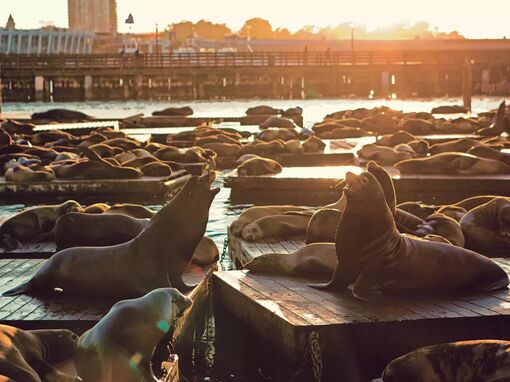
SEE THE SEA LIONS
Ah, San Francisco; where rent is so high that 400-plus sea lions have to share one dock!
Since 1990, a colony of California sea lions have camped out in force on PIER 39. They bark, they nap, and in that way they remind us of ourselves. Below are some notable facts about these iconic animals.
Sea lions are not seals, okay?
Seals are more streamlined with few protruding body features. Their ears and genitals are tucked inside their bodies so they can glide through the water faster, a tactic they possibly learned from Michael Phelps. Also, sea lions have big fins in front that help them walk. So, if an animal is waddling towards you on flippers and you can see its ears, it’s a sea lion—and you should probably move.
How the heck did they get here?
When two sea lions love each other very much…oh, you mean, “How did they get to San Francisco?" The Sea Lion Center of San Francisco says that they arrived here in 1989. Sea lions do this thing called “hauling out”— and if you didn’t picture sea lions dancing to “Roll Out” by Ludacris, you’re not doing it right. Hauling out is when the animals look for spots to rest and get it on between bouts of swimming and hunting. The sea lion population increased in San Francisco after the Loma Prieta earthquake when people started moving their boats away from the pier, thus leaving more space for the sea lions to hang out.
PIER 39
How many sea lions are there in San Francisco?
The number fluctuates based on migratory patterns and prey movements, but at one point there were over a thousand sea lions chilling on the docks! Today, there are 93 sea lions lounging, according to the Sea Lion Center.
Everything You Need to Know About San Francisco's Sea Lions | San Francisco Travel (sftravel.com)
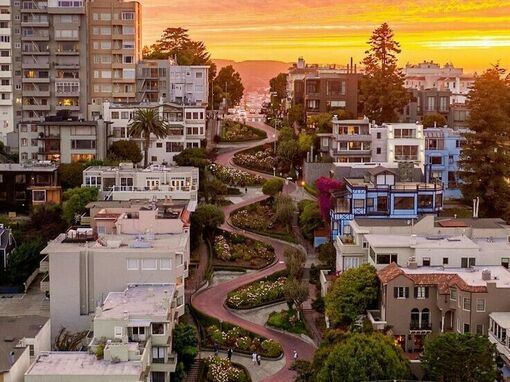
CHECK OUT LOMBARD STREET
Lombard Street, often referred to as the "crookedest street in the world," is one of San Francisco's most iconic and unusual landmarks. This one-block section, with its eight hairpin turns, attracts countless visitors each year, all eager to witness its unique design. But what's the story behind this peculiarly winding road? Let’s unravel the mystery!
The origins of Lombard Street's design date back to the 1920s. Initially, the street was a straight, steep road on Russian Hill. However, its 27% grade was too steep for most vehicles to climb, especially those from the early 20th century. In 1922, property owner Carl Henry proposed the idea of a series of sharp turns to reduce the hill's natural grade to a more manageable 16%. This ingenious solution not only made the street safer but also transformed it into an architectural marvel.
Lombard Street's design is a testament to early 20th-century city planning and the ingenuity required to adapt to San Francisco's hilly terrain. The switchback design was implemented by architect Clyde Healy, who created a more navigable road that respected the area's natural topography. In the process, Lombard Street became a spectacle of urban design.
But Lombard Street isn’t just about its curves. The road is also famous for its stunning visual appeal. The street is beautifully landscaped with flowers and plants, most notably hydrangeas, adding a splash of color to the gray pavement. This meticulous landscaping, combined with the red-brick road, creates a picturesque scene, especially in the spring and summer months when the flowers are in full bloom.
